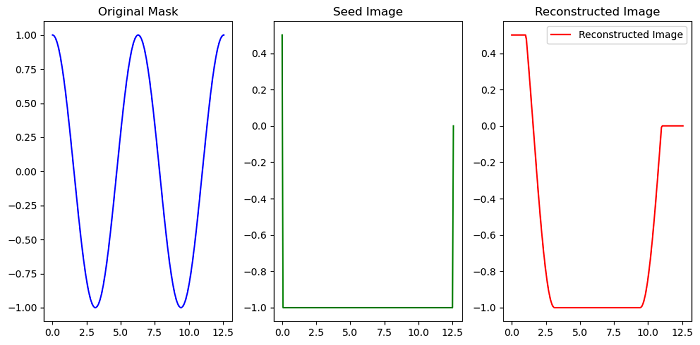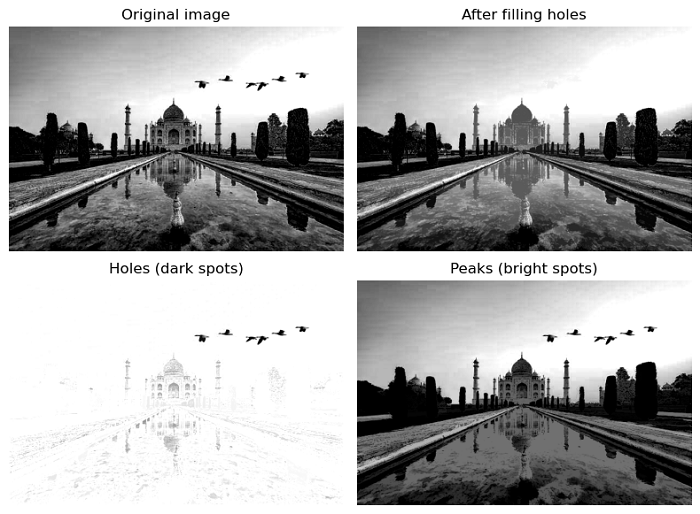
- Scikit Image – Introduction
- Scikit Image - Image Processing
- Scikit Image - Numpy Images
- Scikit Image - Image datatypes
- Scikit Image - Using Plugins
- Scikit Image - Image Handlings
- Scikit Image - Reading Images
- Scikit Image - Writing Images
- Scikit Image - Displaying Images
- Scikit Image - Image Collections
- Scikit Image - Image Stack
- Scikit Image - Multi Image
- Scikit Image - Data Visualization
- Scikit Image - Using Matplotlib
- Scikit Image - Using Ploty
- Scikit Image - Using Mayavi
- Scikit Image - Using Napari
- Scikit Image - Color Manipulation
- Scikit Image - Alpha Channel
- Scikit Image - Conversion b/w Color & Gray Values
- Scikit Image - Conversion b/w RGB & HSV
- Scikit Image - Conversion to CIE-LAB Color Space
- Scikit Image - Conversion from CIE-LAB Color Space
- Scikit Image - Conversion to luv Color Space
- Scikit Image - Conversion from luv Color Space
- Scikit Image - Image Inversion
- Scikit Image - Painting Images with Labels
- Scikit Image - Contrast & Exposure
- Scikit Image - Contrast
- Scikit Image - Contrast enhancement
- Scikit Image - Exposure
- Scikit Image - Histogram Matching
- Scikit Image - Histogram Equalization
- Scikit Image - Local Histogram Equalization
- Scikit Image - Tinting gray-scale images
- Scikit Image - Image Transformation
- Scikit Image - Scaling an image
- Scikit Image - Rotating an Image
- Scikit Image - Warping an Image
- Scikit Image - Affine Transform
- Scikit Image - Piecewise Affine Transform
- Scikit Image - ProjectiveTransform
- Scikit Image - EuclideanTransform
- Scikit Image - Radon Transform
- Scikit Image - Line Hough Transform
- Scikit Image - Probabilistic Hough Transform
- Scikit Image - Circular Hough Transforms
- Scikit Image - Elliptical Hough Transforms
- Scikit Image - Polynomial Transform
- Scikit Image - Image Pyramids
- Scikit Image - Pyramid Gaussian Transform
- Scikit Image - Pyramid Laplacian Transform
- Scikit Image - Swirl Transform
- Scikit Image - Morphological Operations
- Scikit Image - Erosion
- Scikit Image - Dilation
- Scikit Image - Black & White Tophat Morphologies
- Scikit Image - Convex Hull
- Scikit Image - Generating footprints
- Scikit Image - Isotopic Dilation & Erosion
- Scikit Image - Isotopic Closing & Opening of an Image
- Scikit Image - Skelitonizing an Image
- Scikit Image - Morphological Thinning
- Scikit Image - Masking an image
- Scikit Image - Area Closing & Opening of an Image
- Scikit Image - Diameter Closing & Opening of an Image
- Scikit Image - Morphological reconstruction of an Image
- Scikit Image - Finding local Maxima
- Scikit Image - Finding local Minima
- Scikit Image - Removing Small Holes from an Image
- Scikit Image - Removing Small Objects from an Image
- Scikit Image - Filters
- Scikit Image - Image Filters
- Scikit Image - Median Filter
- Scikit Image - Mean Filters
- Scikit Image - Morphological gray-level Filters
- Scikit Image - Gabor Filter
- Scikit Image - Gaussian Filter
- Scikit Image - Butterworth Filter
- Scikit Image - Frangi Filter
- Scikit Image - Hessian Filter
- Scikit Image - Meijering Neuriteness Filter
- Scikit Image - Sato Filter
- Scikit Image - Sobel Filter
- Scikit Image - Farid Filter
- Scikit Image - Scharr Filter
- Scikit Image - Unsharp Mask Filter
- Scikit Image - Roberts Cross Operator
- Scikit Image - Lapalace Operator
- Scikit Image - Window Functions With Images
- Scikit Image - Thresholding
- Scikit Image - Applying Threshold
- Scikit Image - Otsu Thresholding
- Scikit Image - Local thresholding
- Scikit Image - Hysteresis Thresholding
- Scikit Image - Li thresholding
- Scikit Image - Multi-Otsu Thresholding
- Scikit Image - Niblack and Sauvola Thresholding
- Scikit Image - Restoring Images
- Scikit Image - Rolling-ball Algorithm
- Scikit Image - Denoising an Image
- Scikit Image - Wavelet Denoising
- Scikit Image - Non-local means denoising for preserving textures
- Scikit Image - Calibrating Denoisers Using J-Invariance
- Scikit Image - Total Variation Denoising
- Scikit Image - Shift-invariant wavelet denoising
- Scikit Image - Image Deconvolution
- Scikit Image - Richardson-Lucy Deconvolution
- Scikit Image - Recover the original from a wrapped phase image
- Scikit Image - Image Inpainting
- Scikit Image - Registering Images
- Scikit Image - Image Registration
- Scikit Image - Masked Normalized Cross-Correlation
- Scikit Image - Registration using optical flow
- Scikit Image - Assemble images with simple image stitching
- Scikit Image - Registration using Polar and Log-Polar
- Scikit Image - Feature Detection
- Scikit Image - Dense DAISY Feature Description
- Scikit Image - Histogram of Oriented Gradients
- Scikit Image - Template Matching
- Scikit Image - CENSURE Feature Detector
- Scikit Image - BRIEF Binary Descriptor
- Scikit Image - SIFT Feature Detector and Descriptor Extractor
- Scikit Image - GLCM Texture Features
- Scikit Image - Shape Index
- Scikit Image - Sliding Window Histogram
- Scikit Image - Finding Contour
- Scikit Image - Texture Classification Using Local Binary Pattern
- Scikit Image - Texture Classification Using Multi-Block Local Binary Pattern
- Scikit Image - Active Contour Model
- Scikit Image - Canny Edge Detection
- Scikit Image - Marching Cubes
- Scikit Image - Foerstner Corner Detection
- Scikit Image - Harris Corner Detection
- Scikit Image - Extracting FAST Corners
- Scikit Image - Shi-Tomasi Corner Detection
- Scikit Image - Haar Like Feature Detection
- Scikit Image - Haar Feature detection of coordinates
- Scikit Image - Hessian matrix
- Scikit Image - ORB feature Detection
- Scikit Image - Additional Concepts
- Scikit Image - Render text onto an image
- Scikit Image - Face detection using a cascade classifier
- Scikit Image - Face classification using Haar-like feature descriptor
- Scikit Image - Visual image comparison
- Scikit Image - Exploring Region Properties With Pandas
Scikit Image - Morphological Reconstruction of an Image
Morphological reconstruction is a fundamental concept in image processing and computer vision tasks. It is used to enhance or manipulate certain features in an image by combining two images: a "seed" image and a "mask" image. These two images interact to create a new image, which can have specific properties depending on the reconstruction process applied (dilation or erosion). This technique is often used for tasks such as noise reduction, feature enhancement, segmentation, and more.
The scikit library provides a function called reconstruction() in the morphology module to perform the morphological reconstruction of an image.
Using the skimage.morphology.reconstruction() function
The morphology.reconstruction() function is used to perform the morphological reconstruction of an image using either dilation or erosion methods.
Morphological reconstruction by dilation is similar to basic dilation: it replaces low-intensity values with high-intensity values. However, basic dilation uses a footprint to decide how far the value can spread in the input image. In contrast, reconstruction involves two images: a "seed" image that specifies the spreading values and a "mask" image that sets the maximum allowed value for each pixel. The mask image, like the footprint, constrains the spread of high-intensity values.
Reconstruction by erosion is simply the inverse: low-intensity values expand from the seed image but are restricted by the mask image, representing the minimum allowed value.
Another way to view reconstruction is as a method to separate connected regions in an image. For dilation, it links regions marked by local maxima in the seed image: nearby pixels less than or equal to these maxima become part of the connected region. Local maxima with values greater than the seed image will be limited to the seed value.
Syntax
Following is the syntax of this function −
skimage.morphology.reconstruction(seed, mask, method='dilation', footprint=None, offset=None)
Parameters
- Seed (ndarray): The seed image, indicates values that are dilated or eroded.
- Mask (ndarray): The maximum (dilation) or minimum (erosion) values are allowed at each pixel.
- Method {dilation|erosion}, optional: it allows you to choose reconstruction between 'dilation' or 'erosion'. The default is 'dilation'.
- Footprint (ndarray): An optional neighborhood definition, typically a square or cube. Default is the n-D square of radius equal to 1 (i.e. a 3x3 square for 2D images, a 3x3x3 cube for 3D images, etc.).
- Offset (ndarray): An optional parameter specifies the coordinates of the center of the footprint. The default is the geometrical center of the footprint.
Return Value
It returns the reconstructed ndarray, which is the result of the morphological reconstruction process.
Example
The following example demonstrates how morphological reconstruction by dilation can be used to manipulate and limit the spread of intensity values.
import numpy as np
from skimage.morphology import reconstruction
import matplotlib.pyplot as plt
# Create a simple image with peaks
x = np.linspace(0, 4 * np.pi, 200)
y_mask = np.cos(x)
# Create a seed image
y_seed = y_mask.min() * np.ones_like(x)
y_seed[0] = 0.5
y_seed[-1] = 0
# Perform morphological reconstruction by dilation
y_rec = reconstruction(y_seed, y_mask)
# Plot the original mask, seed, and reconstructed image
plt.figure(figsize=(10, 5))
plt.subplot(131)
plt.plot(x, y_mask, 'b', label='Original Mask')
plt.title('Original Mask')
plt.subplot(132)
plt.plot(x, y_seed, 'g', label='Seed Image')
plt.title('Seed Image')
plt.subplot(133)
plt.plot(x, y_rec, 'r', label='Reconstructed Image')
plt.title('Reconstructed Image')
plt.legend()
plt.tight_layout()
plt.show()
Output
On executing the above program, you will get the following output −

Example
This example will perform the hole-filling and peak detection of an image using the morphological reconstruction() function.
import matplotlib.pyplot as plt
import numpy as np
from skimage import io, exposure, morphology
# Load an image
image = io.imread('Images/Blue.jpg')
# Preprocess the image to enhance features
image = exposure.rescale_intensity(image, in_range=(50, 200))
# Fill Holes (using the erosion method)
seed_fill = np.copy(image)
seed_fill[1:-1, 1:-1] = image.max()
mask_fill = image
filled_image = morphology.reconstruction(seed_fill, mask_fill, method='erosion')
# Find Peaks (using the dilation method)
seed_peak = np.copy(image)
seed_peak[1:-1, 1:-1] = image.min()
mask_peak = image
peaks_image = morphology.reconstruction(seed_peak, mask_peak, method='dilation')
# Plot the results
fig, ax = plt.subplots(2, 2, figsize=(8, 6), sharex=True, sharey=True)
ax = ax.ravel()
ax[0].imshow(image, cmap='gray')
ax[0].set_title('Original image')
ax[0].axis('off')
ax[1].imshow(filled_image, cmap='gray')
ax[1].set_title('After filling holes')
ax[1].axis('off')
ax[2].imshow(image - filled_image, cmap='gray')
ax[2].set_title('Holes (dark spots)')
ax[2].axis('off')
ax[3].imshow(peaks_image, cmap='gray')
ax[3].set_title('Peaks (bright spots)')
ax[3].axis('off')
plt.tight_layout()
plt.show()
Output
On executing the above program, you will get the following output −
